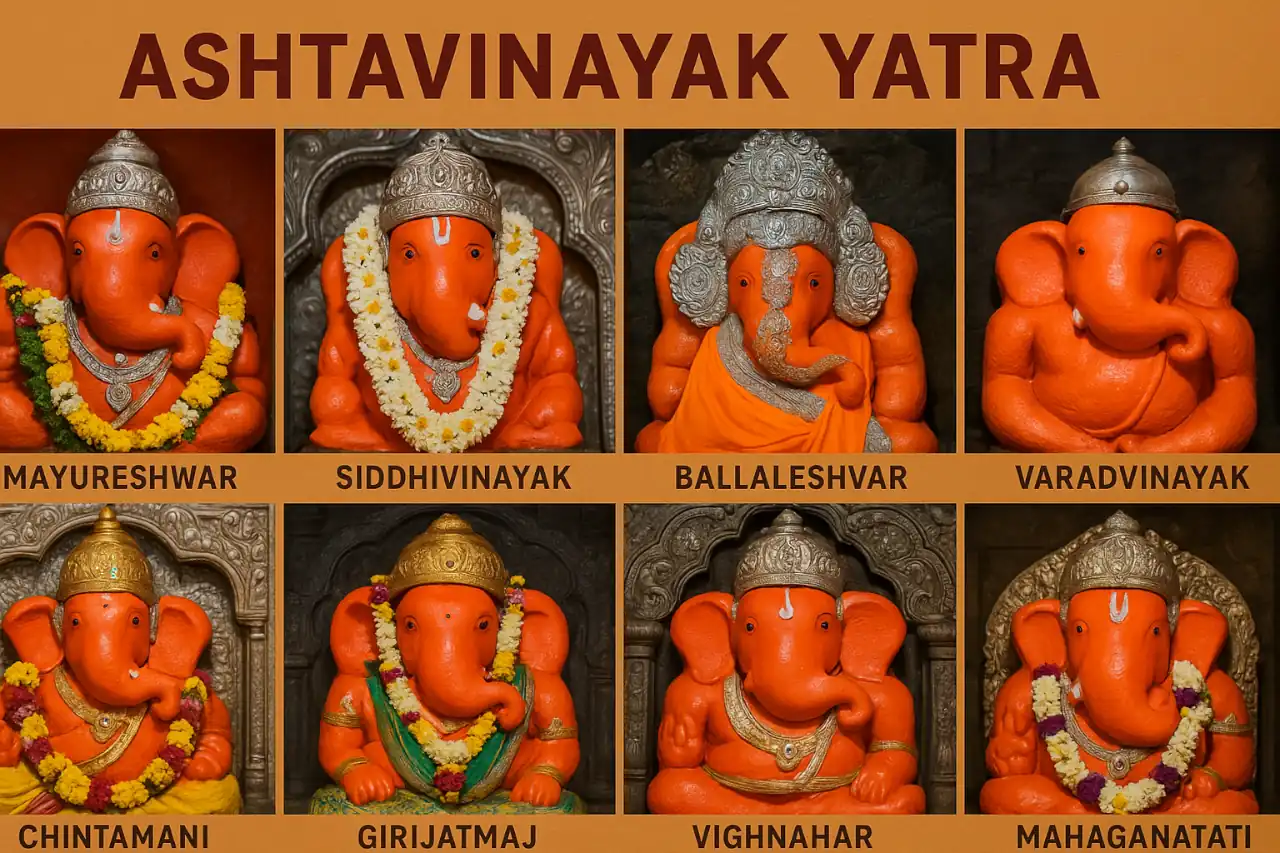🕉️ Ashtavinayak: Your Ultimate Spiritual & Travel Guide to the Eight Sacred Ganesh Temples of Maharashtra
🔴 Introduction: A Journey of Faith and Discovery
In the heart of Maharashtra lies a unique spiritual legacy—a pilgrimage that transcends time and invites devotees on a transformative journey. The Ashtavinayak Yatra takes you through eight ancient temples dedicated to Lord Ganesha, the beloved remover of obstacles. Each temple not only offers a distinct form of the deity but also encapsulates a vibrant history, exquisite architecture, and remarkable local traditions.
Embarking on this sacred journey means more than just visiting temples—it’s an immersion into centuries-old legends and the cultural fabric of rural Maharashtra. As you travel along winding roads, navigate quaint villages, and witness magnificent temple constructions, you are also part of an age-old ritual where devotion, art, and history converge.
This article is your ultimate travel companion, presenting detailed descriptions for each temple, practical travel tips, itineraries, and cultural insights that help you plan your Ashtavinayak Yatra flawlessly. From tips on how to reach these landmarks to advice on local delicacies, handicrafts, and market places, we’ve got every detail covered.
Our comprehensive guide is organised into sections that address essential information for every temple on the circuit—whether you wish to explore the mythic Moreshwar in Morgaon, admire the vibrant Chintamani in Theur, or delve into the architectural wonders of Girijatmaj at Lenyadri. Every section is enriched with granular details on history, temple architecture, travel logistics, and even interviews with local priests and devotees.

As you journey through each temple, you will learn about the transformative power of faith, the interplay of local customs with ancient rituals, and how these sacred sites influence the socio-economic and cultural life of their regions. Our guide is not only informative but also a tribute to the enduring spirit of devotion that these temples inspire.
Set against the backdrop of Maharashtra’s rich landscapes, the Ashtavinayak Yatra is also a celebration of local art, traditions, and culinary delights. Expect to explore vivid market places where artisans sell traditional handicrafts, savour authentic Maharashtrian cuisine, and mingle with locals whose lives are interwoven with the temples’ histories.
Ultimately, this guide invites you to embark on a multi-sensory adventure that is as enlightening as it is exciting. The ancient legends, divine blessings, and majestic temple complexes await you—a timeless odyssey that begins with a single step toward faith and discovery.
Let this guide be your stepping stone into a world where spirituality meets history, and every mile you traverse is filled with the echoes of age-old chants, resplendent temple bells, and the warm smiles of devoted locals. Welcome to the Ashtavinayak Yatra—an unforgettable journey towards inner peace and cultural enlightenment.
🔘 Understanding Ashtavinayak: Origins, Legends, and Cultural Significance
The term Ashtavinayak directly translates to Eight forms of Vinayaka” and refers to a carefully preserved pilgrimage circuit comprising eight uniquely revered temples dedicated to Lord Ganesha. These temples are predominantly located in western Maharashtra and have earned their distinction through centuries of patronage by the Maratha and Peshwa dynasties.
🔘 Origins and Scriptural Roots
Ancient scriptures such as the Mudgala Purana detail the divine manifestations of Lord Ganesha in these specific locales. Legends surrounding each temple narrate the heroic deeds of Ganesha—whether it’s his role in slaying demons or his benevolent intercession that dispels obstacles from the lives of devotees. This mythological tapestry not only enhances the spiritual allure of the temples but also cements their position as centres of worship, where ritual and legend meet.
🔘 Cultural and Historical Context
During the Peshwa era, the Ashtavinayak temples flourished under royal patronage, becoming epicentres of art, architecture, and religious ceremony. The temples are imbued with a rich array of cultural influences—from the intricate stone carvings that showcase expertise from the Hemadpanthi style, to the magnificent Sabha-mandaps (Assembly halls) where prayers and community events take place. Each temple carries not only religious significance but also tells a vibrant story about the socio-cultural evolution of Maharashtra.
🔘 Spiritual Importance and Devotional Practices
For millions of devotees, visiting these eight temples is regarded as a highly auspicious endeavour—one that promises blessings, removes obstacles, and paves the path to success. Pilgrims believe that by circumambulating these sacred sites, they renew their spiritual energy and forge an unbreakable bond with the divine. The Ashtavinayak Yatra is more than a physical journey; it is a meditative passage that nurtures the soul and uplifts the spirit.
Also Read
Sarasbaug Pune: A Timeless Tapestry of History, Spirituality, and Natural Beauty
🟢 Detailed Temple Guide
The following sections provide an in-depth look at each of the eight Ashtavinayak temples. For every temple, you will find rich details on its history, architectural style, travel logistics, nearby attractions, and practical tips on how to make the most of your visit.
So, let’s set forth on this sacred odyssey—where every mile echoes the chant, “Ganpati Bappa Morya!”
🛕 Moreshwar Ganpati Temple, Morgaon
➤ Overview & History
Located in the quaint village of Morgaon—often referred to as the “Village of Peacocks”—the Moreshwar Ganpati Temple is traditionally the first stop on the Ashtavinayak Yatra. Legend has it that Lord Ganesha incarnated as Mayureshwar (or Moreshwar) to defeat the demon Sindhu, and afterward chose Morgaon as his abode. The temple’s origins are linked with the revered Ganapatya saint, Morya Gosavi, who elevated the site to prominence during the Peshwa reign.
➤ Architecture & Design
This ancient temple flaunts a blend of traditional Hindu design with hints of regional influences. Constructed primarily of locally quarried stone, the temple exhibits intricate carvings that depict various mythological motifs and the divine Leelas (acts) of Lord Ganesha. The structure is marked by four impressive Deepmalas (lamp towers) and an iconic boundary wall adorned with sculptures of Ganesha in different forms. A dedicated Nandi statue—symbolising divine guardianship—stands guard near the entrance.
➤ How to Reach
⦿ By Road: Easily accessible from Pune (approximately 70 km), with regular state transport buses and private taxis plying on well-maintained roads.
⦿ By Rail: The nearest railway station is Jejuri, located about 17 km from the temple, which connects to Pune Junction.
⦿ By Air: Pune International Airport is the closest major airport.
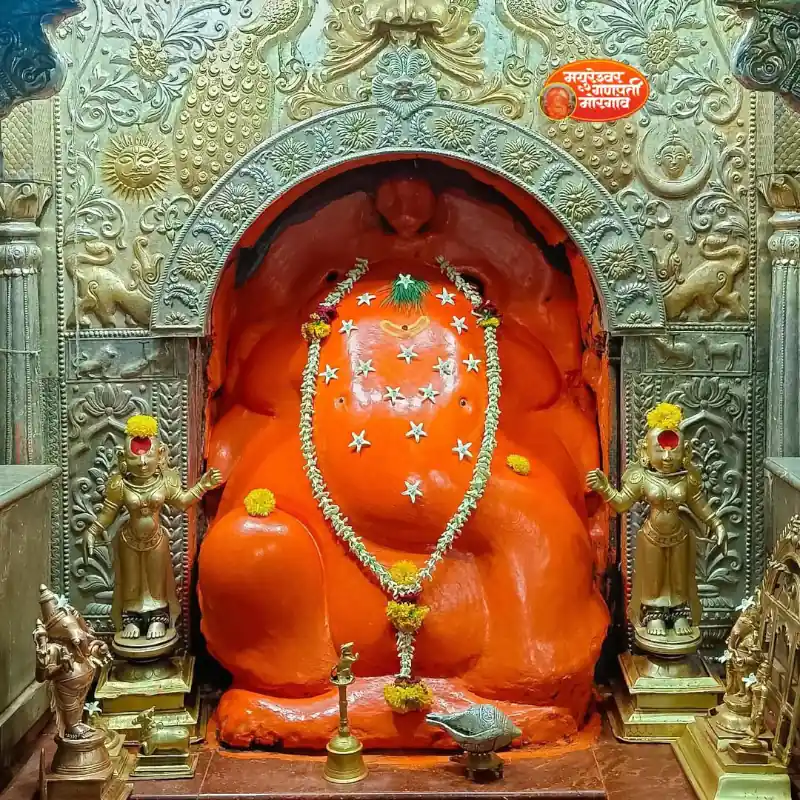
➤ Best Time to Visit
Ideal during the winter months (October to February) when the weather is pleasant. Although Ganesh Chaturthi attracts large crowds, visiting early in the morning or late in the evening is recommended for a peaceful experience.
➤ Nearby Attractions
⦿ Jejuri Khandoba Temple: Only 17 km away, offering insights into regional deity worship.
⦿ Baramati: A town rich in cultural heritage and culinary delights, about 35 km from Morgaon.
⦿ Local Bazaars: Explore traditional handicrafts, textiles, and authentic Maharashtrian snacks.
➤ Local Cuisine & Marketplaces
Taste local specialties such as Misal Pav, Vada Pav, and Puran Poli in nearby villages. Markets in Morgaon often showcase a range of traditional items—from handcrafted jewellery to locally made pottery.
➤ Local Lifestyle & Handicrafts
Residents of Morgaon live a simple yet culturally vibrant lifestyle. Their crafts—ranging from pottery to wood carving—reflect centuries of tradition passed down through generations.
➤ Things to Do
⦿ Attend the early morning aarti to witness the serene rituals.
⦿ Participate in local festivals and Sammelan (Gatherings) during Ganesh Chaturthi.
⦿ Explore the temple compound and soak in the history and architecture.
🛕 Chintamani Ganpati Temple, Theur
➤ Overview & History
Situated just 25 km from Pune, the Chintamani Temple in Theur is renowned for its picturesque location at the confluence of the Mula and Mutha rivers. According to legend, this temple is the site where Lord Ganesha recovered the coveted Chintamani gem for Sage Kapila, symbolising the removal of worries (“Chinta” means worry). Historically, the temple gained prominence through the patronage of Madhavrao Peshwa, who not only renovated the temple but also held it dear during his final days.
➤ Architectural Splendor
The temple boasts the classic Hemadpanthi style with intricately carved stone sculptures and a distinct Sabha-mandap constructed from finely crafted teak wood. The idol of Chintamani Ganpati is uniquely enthroned facing east, with his trunk turned to the left. Adorned with precious stones, the idol captures the divine essence and is a focal point of daily rituals.
➤ How to Reach
⦿ By Road: Well-connected by regular buses and private taxis from Pune via the Mumbai-Khandala road.
⦿ By Rail: Pune Junction is your nearest rail hub, with onward local transport to Theur.
⦿ By Air: Pune International Airport serves as the entry point for air travellers.
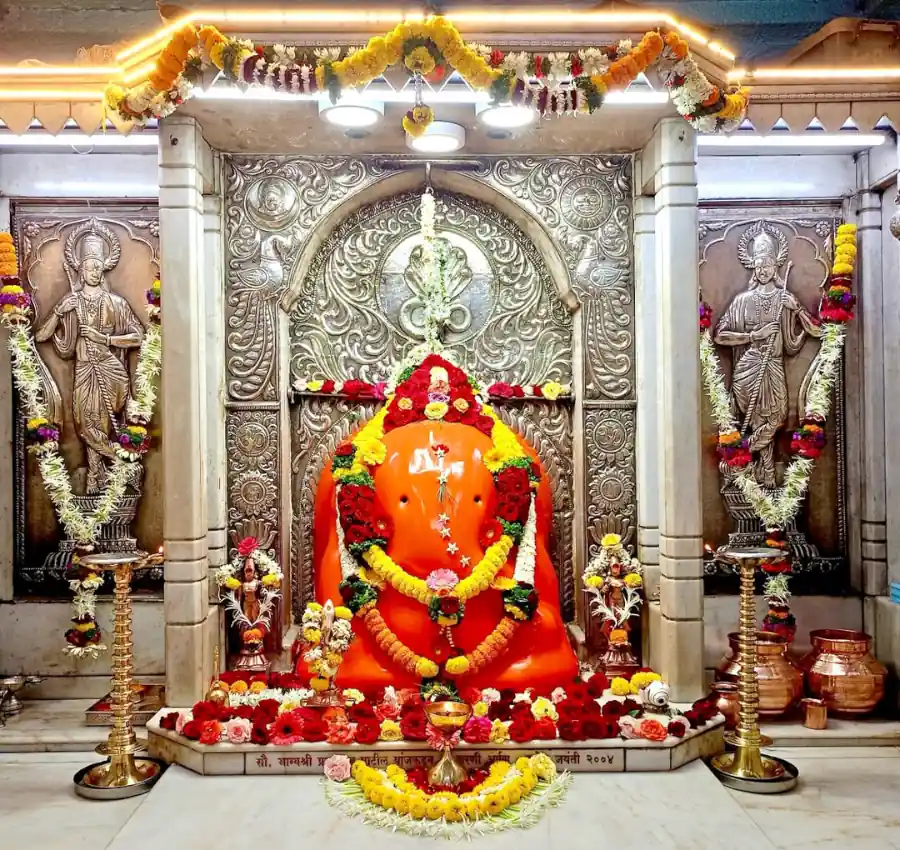
➤ Best Time to Visit
Winter (October to February) is optimal due to the pleasant climate, though the monsoon season sees a surge in devotees during Ganesh Chaturthi. Mornings are perfect for a quiet Darshan amid fewer crowds.
➤ Nearby Attractions
⦿ Aga Khan Palace, Pune: A historical monument just 20 km away.
⦿ Dagdusheth Halwai Ganpati Temple: A famed temple in Pune renowned for its opulent festivities.
⦿ Tukai Devi Temple: Another local spiritual site enriching the region’s cultural heritage.
➤ Local Food, Markets, & Lifestyle
Local eateries serve traditional Maharashtrian delicacies like Sabudana Khichdi and Poha. The vibrant bazaars in Theur provide handmade jewellery, ethnic clothing, and delicious street foods. Engage with locals to learn about traditional crafts like weaving and pottery.
➤ Things to Do & Practical Tips
⦿ Join the daily Pooja ceremonies and observe the temple’s Aartis.
⦿ Enjoy a leisurely stroll along the riverbanks Post-darshan.
⦿ Purchase traditional souvenirs from nearby market stalls.
⦿ Wear light, comfortable clothing along with a hat or scarf during the sun’s peak.
🛕 Siddhivinayak Temple, Siddhatek
➤ Overview & History
Siddhatek in Ahmednagar district is home to the only Ashtavinayak temple located outside the Pune-Raigad region. Legend holds that this temple is where Lord Vishnu himself performed penance and where Ganesha manifested in a unique form—with his trunk turned to the right. Built originally by Ahilyabai Holkar in the 18th century, the temple’s history is deeply intertwined with local mythology and ancient rituals.
➤ Architectural Highlights
The temple stands on a hillock along the banks of the Bhima River, offering panoramic views of the surrounding countryside. Its design reflects simple, yet classic Hindu temple architecture with a sanctum sanctorum built in stone, pristine carvings, and open corridors for Pradakshina (circumambulation). The unusual rightward trunk of the idol renders it exceptionally auspicious among devotees.
➤ How to Reach
⦿ By Road: Accessible from Daund (approx. 19 km) and via the scenic Daund-Kasti-Padgaon route.
⦿ By Rail: The nearest station is Daund Railway Station, well-connected to major cities.
⦿ By Air: Pune and Mumbai serve as the nearest major airports, from where roads and buses are available.
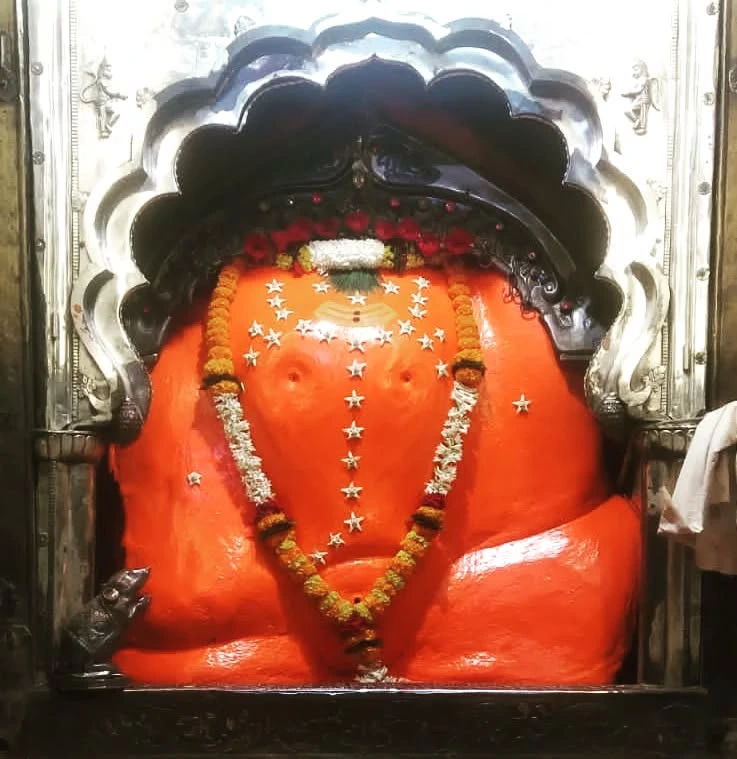
➤ Best Time to Visit
The ideal time is during the cooler months (October to February). Although the temple maintains a quiet charm year-round, the festive fervour during Ganesh Chaturthi creates a spiritually charged atmosphere.
➤ Nearby Attractions
⦿ Jagdamba Devi Temple at Rashin: A noted religious site nearby.
⦿ Local Boating on the Bhima River: Offering peaceful scenic views.
⦿ Traditional Village Markets: Where local produce, spices, and handmade crafts are sold.
➤ Local Marketplaces & Cuisine
Explore small local markets to sample authentic regional snacks like Modak and Shrikhand. The local lifestyle is deeply rural, with warm hospitality and a close-knit community vibe where folklore is alive in everyday conversation.
➤ Things to Do & Travel Tips
⦿ Participate in the temple’s daily rituals and the special Aartis.
⦿ Enjoy a boat ride on the Bhima River for a serene experience.
⦿ Bring comfortable shoes for the climb and observe the traditional practice of circumambulation.
🛕 Mahaganapati Temple, Ranjangaon
➤ Overview & Historical Significance
Located in the Shirur taluka of Pune district, the Mahaganapati Temple in Ranjangaon is steeped in legend and ancient history. According to myth, this temple is the site where Lord Shiva revered Ganesha before his battle with the demon Tripurasura—earning it the title “Tripurarivade”. Renovated multiple times by the Peshwa rulers, the temple exudes regal charm and is considered one of the most potent shrines in the Ashtavinayak circuit.
➤ Architectural Features
This temple is celebrated for its unique design that allows the early morning sun’s rays to fall directly on the idol during Dakshinayan (southern sun movement). The grand entrance features statues of Jay and Vijay—the celestial gatekeepers—while the sanctum reveals an intricately carved idol of Lord Ganesha flanked by his consorts, Riddhi and Siddhi. The structure is robust, with wood and stone elements that were enhanced during the Peshwa era.
➤ How to Reach
⦿ By Road: Approximately 50 km from Pune, with frequent bus services and well-maintained highways.
⦿ By Rail: The nearest station is Uruli, about 16 km away.
⦿ By Air: Pune Airport is the best option, from where one may hire a taxi or rent a vehicle.
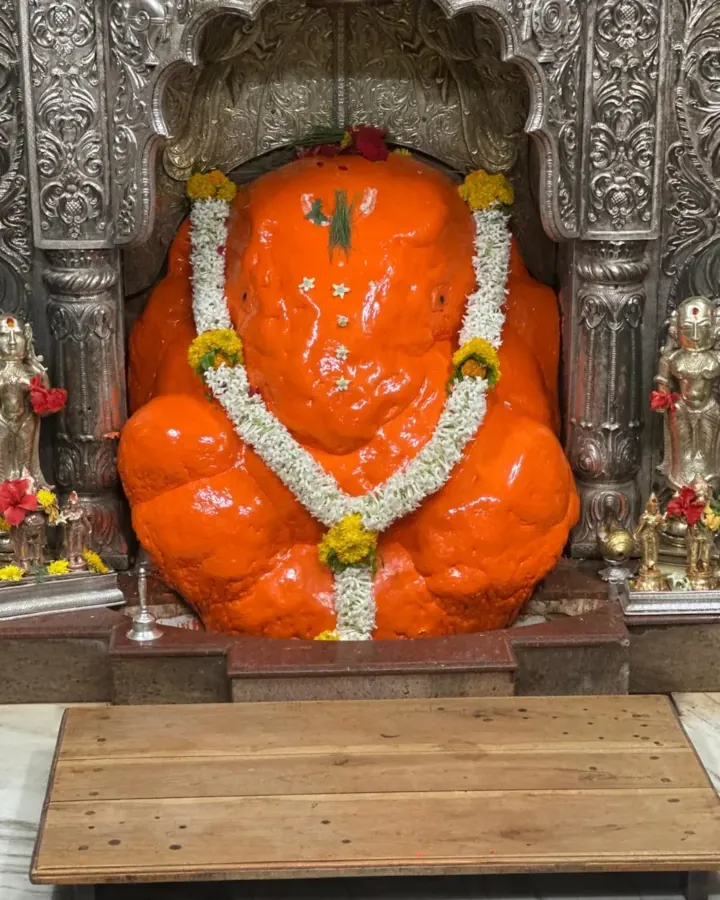
➤ Best Time to Visit
The temple is accessible year-round, but the post-monsoon period (October to February) is ideal for comfortable travel and a peaceful Darshan. Festivals like Ganesh Chaturthi enhance the spiritual atmosphere, though these periods tend to be crowded.
➤ Nearby Attractions
⦿ Pune City Attractions: Visit cultural landmarks like Shani Shingnapur or the Dagdusheth Halwai Ganpati Temple.
⦿ Local Heritage Sites: Explore small forts, ancient caves, and scenic spots in Shirur taluka.
⦿ Handicraft Stores and Local Markets: Where traditional Marathi crafts and textiles are available.
➤ Local Culture & Culinary Delights
The local markets offer homemade snacks, including Modaks and Puran Poli. The lifestyle in Ranjangaon is a mix of age-old traditions and modern living. Devotees often share stories of temple legends with warmth and humour, making the pilgrimage as much a cultural exchange as it is a spiritual endeavour.
➤ Things to Do
⦿ Witness the sunrise as it touches the idol—a breathtaking sight.
⦿ Join in on community processions and special Puja ceremonies during festivals.
⦿ Explore the temple’s museum (if available) and gather insights into local history and art.
⦿ Wander through the nearby bazaars and sample local cuisine.
🛕 Vighnahar Ganpati Temple, Ozar
➤ Overview & Spiritual Significance
Located in Ozar, within the Junnar taluka of Pune district, the Vighnahar Ganpati Temple is famed for its golden dome and the unique story of how Chimaji Appa, a prominent Peshwa military commander, once adorned the temple’s shikhara (spire) with gold. Known also as Vigneshwar or Vighnaharta, this temple celebrates Ganesha’s ability to remove obstacles and is visited by thousands during Ganesh Chaturthi.
➤ Architectural Highlights
The temple complex is a marvel of traditional craftsmanship featuring a striking gold-plated dome, intricately carved pillars, and spacious halls. The central shrine houses a self-manifested (Swayambhu) idol of Lord Ganesha, distinguished by its leftward-turning trunk and jewels in its eyes. The temple’s layout includes multiple Prakarams (courtyards) and Deepamalas (lamp towers) that enhance its spiritual ambiance.
➤ How to Reach
⦿ By Road: Located about 85 km from Pune via the Pune – Nashik highway, with numerous buses and taxis available.
⦿ By Rail: Nearest railway stations are Pune and Talegaon, providing convenient connectivity.
⦿ By Air: Pune International Airport is the closest airport.
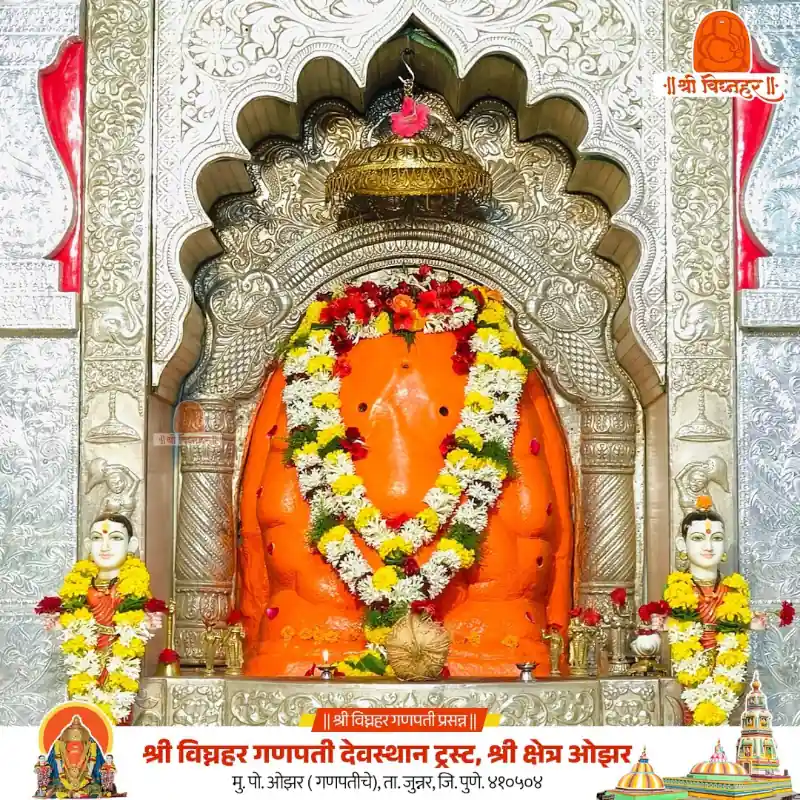
➤ Best Time to Visit
Visiting is pleasant throughout the year, with the period from October to March offering ideal weather. Note that the monsoon season may cause slight disruptions due to heavy rain, though festival times bring a mesmerising vibrance to the temple festivities.
➤ Nearby Attractions
⦿ Kukadi River: Enjoy scenic views along the riverbanks bordering the temple.
⦿ Lenyadri Caves: Just a short drive away, these ancient rock-cut caves offer a glimpse into the region’s Buddhist past and subsequent Hindu adaptation.
⦿ Local Bazaars: Explore traditional crafts, textiles, and souvenirs unique to the region.
➤ Local Marketplaces & Cuisine
Ozar offers traditional Maharashtrian fare with stalls serving spicy Bhajiyas, Modaks, and an assortment of street snacks. Local markets also offer artisanal crafts and souvenirs that celebrate the cultural heritage of the region.
➤ Things to Do
⦿ Marvel at the golden dome and intricate temple carvings.
⦿ Participate in daily Aartis and special Puja sessions.
⦿ Stroll through the temple premises to absorb its serene energy, and interact with local devotees to understand the temple’s historical significance.
🛕 Girijatmaj Ganpati Temple, Lenyadri
➤ Overview & Spiritual Backdrop
Nestled on a hilltop in the ancient Lenyadri caves near Junnar, the Girijatmaj Ganpati Temple is unique as it is carved out of a single rock. Legend has it that Goddess Parvati meditated in these caves for 12 years to beget a child, leading to the miraculous birth of Lord Ganesha, hence the name “Girijatmaj” (meaning “son of Girija”, another name for Parvati).
➤ Architectural and Natural Splendour
The temple is integrated into an ancient Buddhist cave complex, which adds a fascinating layer of history to its spiritual significance. Accessible by climbing approximately 300–315 stone steps, the temple offers breathtaking views of the surrounding hills and valleys. Inside, the temple complex features spacious Sabha-mandaps (assembly halls) without the need for supporting pillars, displaying exemplary rock-cut craftsmanship and ancient murals that narrate the tales of Lord Ganesha’s divine exploits.
➤ How to Reach
⦿ By Road: Approximately 90 km from Pune, with private vehicles or state-run buses available.
⦿ By Rail: The closest railway station is in Junnar, which is well connected by local transit.
⦿ By Air: Pune Airport is the most accessible option for air travel.
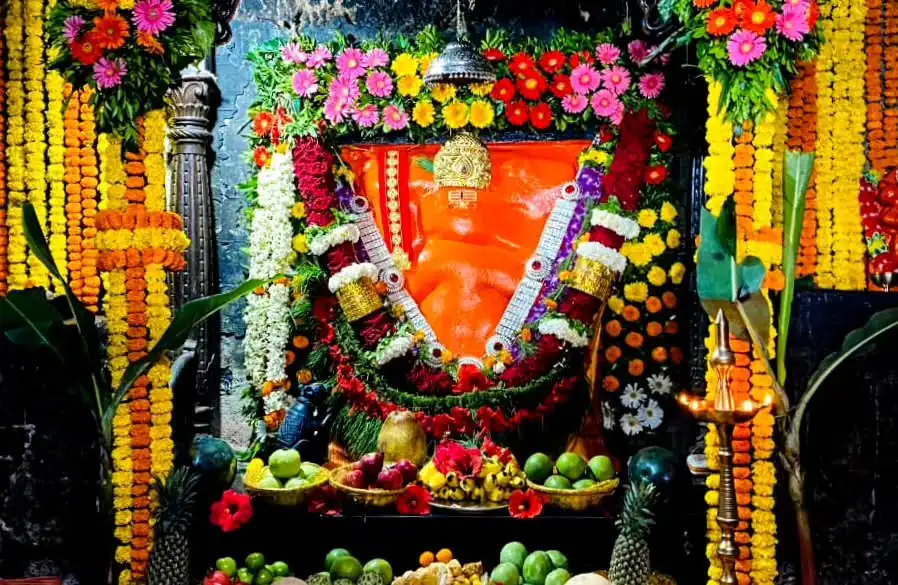
➤ Best Time to Visit
The best time is during the cooler months (October to February) to comfortably negotiate the climb. Early mornings are ideal not only for avoiding crowds but also for witnessing the play of sunrise over the rugged landscapes.
➤ Nearby Attractions
⦿ Buddhist Caves of Lenyadri: Explore additional caves and ancient rock art that provide historical context for the temple’s origins.
⦿ Scenic Trekking Routes: Ideal for nature walks and gaining panoramic views of the Western Ghats.
⦿ Local Cultural Spots: Interact with local guides who share folklore and historical insights about the area.
➤ Local Lifestyle & Handicrafts
The region near Lenyadri is sparse in urban development but rich in tradition. Local villagers offer handmade souvenirs, including embroidered textiles and rustic pottery, which reflect the simple yet deeply rooted cultural heritage of the area.
➤ Things to Do
⦿ Climb the stone steps and enjoy the meditation-friendly ambiance of the natural surroundings.
⦿ Visit the Sabha-mandap and admire the ancient murals and carvings.
⦿ Spend time in quiet meditation or photography, capturing the natural beauty of the rugged hill and cave environs.
🛕 Varadvinayak Temple, Mahad
➤ Overview & Legend
Set in the small town of Mahad in Raigad district, Varadvinayak Temple is dedicated to the deity known as Varada Vinayaka—the bestower of boons. The temple’s origin is steeped in legend, where the swayambhu (self-manifested) idol was discovered immersed in a lake in 1690 AD and later enshrined by Peshava Sardar Ramji Mahadev Biwalkar in 1725. A continuously burning oil lamp (Nandadeep) since 1892 adds to the temple’s mystique.
➤ Architectural Details
The temple complex is modest yet striking, with the main shrine facing east and the idol’s trunk turned to the left. The surroundings feature a pristine pond on one side, and four elephant statues guard the temple from all sides, symbolising protection. Delicate stone work, interwoven with local motifs and inscriptions, underlines the craftsmanship of the Maratha era.
➤ How to Reach
⦿ By Road: Easily accessible from Mumbai (approximately 63 km) and Pune (85 km) via well-maintained highways.
⦿ By Rail: The nearest railway stations are Karjat or Khopoli, from where one can hire local transport.
⦿ By Air: Mumbai’s Chhatrapati Shivaji International Airport or Pune International Airport serve as gateways.
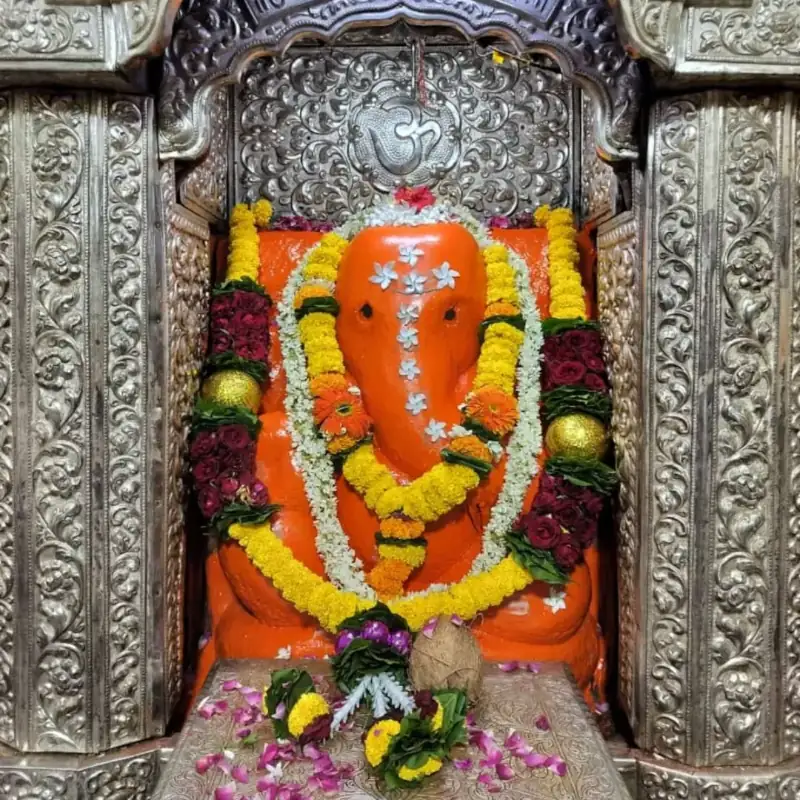
➤ Best Time to Visit
The optimal season is from October to February, avoiding the heavy monsoon rains. Festive occasions such as Maghi Chaturthi bring special vigour to the temple, though they attract larger crowds.
➤ Nearby Attractions
⦿ Scenic Hillocks and Ghats: The natural surroundings of Mahad offer trekking paths and scenic picnic spots.
⦿ Local Markets: Visit bustling bazaars to purchase regional handicrafts and traditional Maharashtrian foods.
⦿ Historical Sites: Explore nearby ancient forts and temples that chronicle the rich history of the Raigad district.
➤ Local Culture, Economy & Lifestyle
Mahad is a confluence of ancient traditions and modern development. The local economy thrives on agriculture, handicrafts, and pilgrimage tourism. Marathi is the dominant language, and festivals often see a blend of devotional fervour with local culinary delights such as Bhakri, Varan (Plain Dal) & Bhat (Rice), Vegetables (Mediumly spiced) and chutney made from locally sourced produce.
➤ Things to Do
⦿ Experience the sacred Darshan during early morning Pujas.
⦿ Interact with local devotees and temple priests to learn more about the legends and rituals.
⦿ Enjoy a leisurely boat ride on the temple’s pond.
⦿ Visit local markets to witness the lively trade of traditional handicrafts.
🛕 Ballaleshwar Ganpati Temple, Pali
➤ Overview & Significance
The Ballaleshwar Ganpati Temple in Pali is unique among the Ashtavinayak temples as it is named after a young devotee, Ballal, whose faith is immortalised in the temple’s lore. This temple, steeped in local legend, stands amidst scenic landscapes between the fort of Sarasgad and the Amba river, representing the divine interplay between devotee and deity.
➤ Historical & Architectural Insights
Originally constructed in wood in the 17th century and later rebuilt in stone around 1760 by prominent local patrons, the temple features an east-facing sanctum that allows the first rays of the sun to illuminate the idol. The inner sanctum’s architecture is compact yet artistically carved, with sculptural details that depict Lord Ganesh’s attributes, flanked by his consorts, Riddhi and Siddhi. Eight pillars at the entrance symbolise the eight directions of the universe—a nod to the temple’s part in the sacred Ashtavinayak circuit.
➤ How to Reach
⦿ By Road: Pali is about 38 km from Khopoli and 111 km from Pune, with clear signage and maintained road networks.
⦿ By Rail: Local transport from nearby railway hubs in Khopoli or Panvel is available.
⦿ By Air: Mumbai is the nearest major hub, with frequent transfers by taxi or bus.
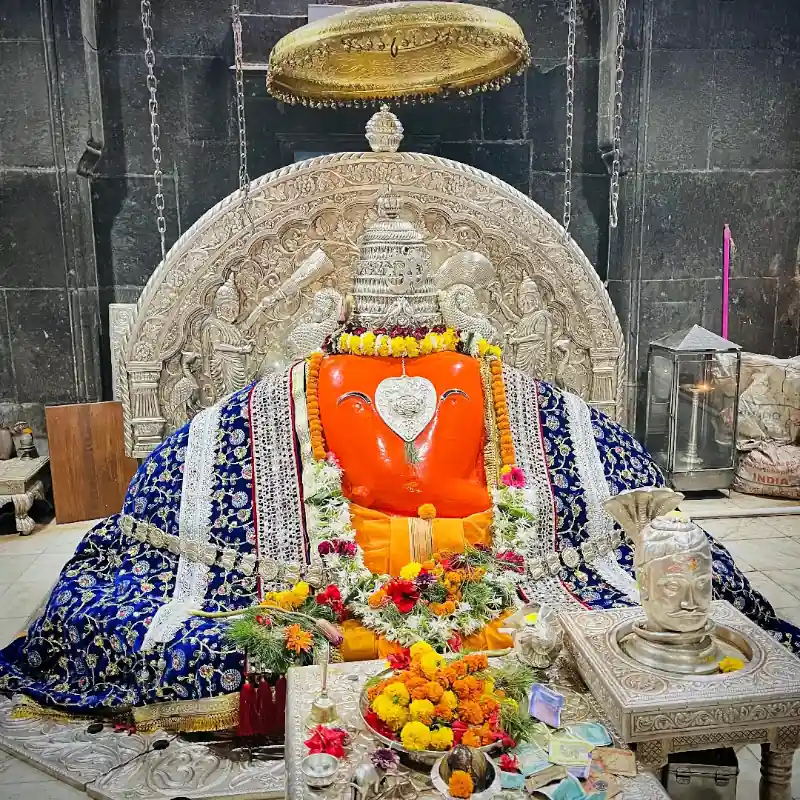
➤ Best Time to Visit
The temple welcomes devotees throughout the year. However, the festival season during Ganesh Chaturthi (often in August or September) sees special processions and large gatherings—ideal for those who want to experience the vibrant celebrations.
➤ Nearby Attractions
⦿ Fort Sarasgad: Located nearby, offering historical insights and panoramic views of the region.
⦿ Local Hot Springs: Relaxing natural springs that attract both pilgrims and tourists.
⦿ Traditional Villages: Witness rural Maharashtrian life and sample regional cuisine.
➤ Local Marketplace, Food & Lifestyle
The village of Pali has a lively market where you can buy handmade artefacts, local spices, and traditional sweets like Modak. The community is known for its time-honoured traditions, with festivals often accompanied by folk dances, music, and local stories that have been passed down over generations.
➤ Things to Do
⦿ Participate in the daily aarti and special rituals during festive days.
⦿ Explore the temple premises and admire the detailed carvings and sculptures.
⦿ Shop for unique handicrafts that make for perfect souvenirs.
⦿ Spend quiet moments in meditation at the temple’s serene courtyard.
🟣 Beyond the Temples: Local Culture, Climate, and Practical Travel Tips
➤ Local Demographics & Economy
Maharashtra’s regions encompassing the Ashtavinayak temples have a rich cultural tapestry. Predominantly Marathi-speaking, these areas are known for their agriculture, local handicrafts, and burgeoning tourism sectors. Regions like Pune, Ahmednagar, and Raigad are evolving with modern amenities while still cherishing centuries-old traditions.
⦿ Talukas & Districts: The temples are located in diverse talukas including Baramati (Morgaon), Haveli (Theur), Karjat/Rashin (Siddhatek), Shirur (Ranjangaon), Junnar (Ozar & Lenyadri), and Khalapur (Mahad/Pali).
⦿ Notable People: Many revered saints and cultural figures such as Morya Gosavi, Narayan Maharaj, and several Peshwa lineage members have been closely associated with these temples.
➤ Climate & Weather Conditions
Most regions in the Ashtavinayak circuit enjoy a moderate climate:
⦿ Summer (March to June): Warm to hot days; early morning or late afternoon visits are recommended to avoid extreme heat.
⦿ Monsoon (June to September): High rainfall, lush greenery; travel may be challenging on some routes.
⦿ Winter (October to February): Cool, pleasant weather ideal for travel and spiritual activities.
Always check local weather forecasts and plan outdoor activities accordingly.
➤ Practical Travel Tips
⦿ Transport: While many of the temples are well-connected by road, hiring a private car can offer flexibility. State-run buses operate reliably between major cities such as Pune, Mumbai, and the pilgrimage sites.
⦿ Accommodation: Options range from budget guesthouses and Dharmashalas managed by temple trusts to mid-range hotels in nearby cities like Pune and Nashik.
⦿ Local Interaction: Engage with temple priests and local devotees. Many are happy to share personal stories, historical anecdotes, and even offer short interviews that provide deep cultural insights.
⦿ Health & Safety: Carry bottled water, sunscreen, and a hat. Be prepared for long walks or climbs, especially at Lenyadri and other hilltop temples.
⦿ Dress Code: Wear modest clothing—covering shoulders and knees—as a mark of respect at religious sites.
⦿ Booking Rituals: During festival seasons, online booking for temple Darshan can help you avoid long queues.
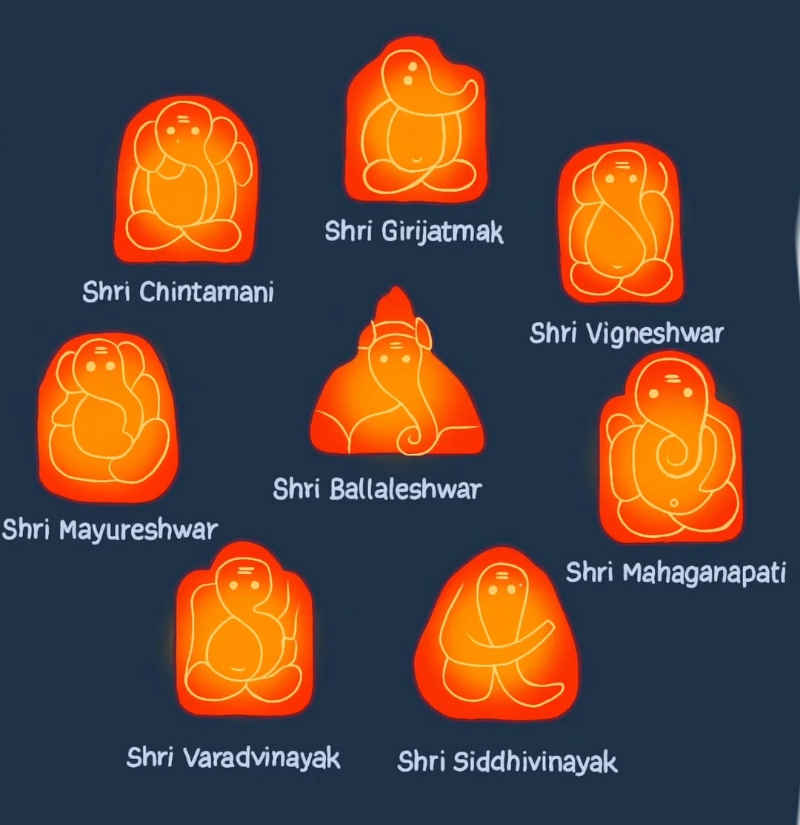
➨ Itinerary Planning: For a comprehensive journey, consider a 2-3 day itinerary:
⦿ Day 1: Start from Morgaon; visit Moreshwar Ganpati, then proceed to Theur.
⦿ Day 2: Head to Siddhatek and Ranjangaon; enjoy local cuisine and cultural stops.
⦿ Day 3: Visit Ozar, Lenyadri, Mahad, and finally Pali. Use an itinerary app to manage logistics and timings.
➤ Local Handicrafts & Culinary Highlights
⦿ Handicrafts: Look for traditional Kolhapuri chappals, Warli paintings, and handwoven textiles in local markets.
⦿ Cuisine: Savour authentic Maharashtrian dishes like Puran Poli, Shrikhand, and Modak. Street food such as Vada Pav and Misal Pav offer a quick snack during your journey.
⦿ Festivals and Cultural Performances: Keep an eye on local calendars—temple festivals not only add spiritual energy but also feature local dance, music, and art, providing a window into the region’s cultural heritage.
🟠 Extended Itineraries and Interviews with Locals
➤ Sample Itineraries
👉 2-Day Itinerary:
➨ Day 1 Itinerary:
⦿ Morning: Begin your journey at Moreshwar Ganpati in Morgaon. Enjoy breakfast in a local eatery before attending the morning aarti.
⦿ Midday: Proceed to Theur’s Chintamani Temple, and take time to explore the nearby riverfront.
⦿ Evening: Return to Morgaon for the evening aarti and local dinner.
➨ Day 2 Itinerary:
⦿ Morning: Depart for Siddhatek for an early morning Darshan followed by a scenic drive to Ranjangaon.
⦿ Afternoon: Enjoy a guided tour of the Mahaganapati Temple and local heritage sites.
⦿ Evening: Conclude your day with a drive to Ozar, followed by a local cultural performance and overnight stay in a Dharmashala or budget hotel near the temple.
👉 3-Day Itinerary:
⦿ Day 1: Focus on the southern circuit (Morgaon, Theur, and Siddhatek).
⦿ Day 2: Explore central circuit (Ranjangaon, Ozar, and Lenyadri) including extended cultural tours and interviews with local temple caretakers about historical narratives.
⦿ Day 3: Visit Mahad and Pali temples, with stops at local markets and culinary tours in small villages, offering insights on traditional lifestyles and local economy.
➤ Interviews and Cultural Analysis
While on your yatra, try to interact with local temple priests and elderly devotees. For example, a priest at Morgaon might share anecdotes about how the chant “Mangalmurti Morya” became popular after receiving divine blessings from Lord Ganesha. In Theur, long-standing families recount tales passed down from the time of Madhavrao Peshwa — stories that not only verify historical facts but also enrich your understanding of regional traditions. An interview with a local market vendor in Pali can reveal how the sale of handcrafted modaks and traditional jewellery supports the local economy, tying together culture, spirituality, and modern livelihood.
These personal interviews add a distinct human element to the pilgrimage experience, bridging the gap between centuries-old legends and contemporary life. They offer a rare glimpse into how the ancient traditions of devotion continue to shape everyday lives and inspire local communities to preserve their cultural heritage.
🟤 Frequently Asked Questions (FAQs)
What is the significance of the Ashtavinayak Yatra?
The Ashtavinayak Yatra is a pilgrimage to eight holy temples dedicated to Lord Ganesha in Maharashtra. It is believed that completing this journey bestows blessings, removes obstacles, and fulfils devotees’ wishes.
How many temples are there in the Ashtavinayak circuit?
There are eight temples — Moreshwar (Morgaon), Chintamani (Theur), Siddhivinayak (Siddhatek), Mahaganapati (Ranjangaon), Vighnahar (Ozar), Girijatmaj (Lenyadri), Varadvinayak (Mahad), and Ballaleshwar (Pali).
What are the best months to undertake the Ashtavinayak Yatra?
The ideal time to undertake the pilgrimage is from October to February when the weather is pleasant. However, many devotees also travel during Ganesh Chaturthi (monsoon season) despite the crowds.
What are the transport options for reaching these temples?
All eight temples are accessible by road, with state buses and private taxis readily available from major cities like Pune and Mumbai. The nearest railway and air connections vary by temple, so check local guides for specific details.
Are there any special rituals to be performed at these temples?
Daily rituals such as Poojas, Abhishek (ritual bathing), and Aartis are conducted at each temple. Some temples also offer the opportunity for circumambulation and personalised blessings.
What local cuisines and market items should I try during my journey?
Be sure to try traditional Maharashtrian dishes like Puran Poli, Misal Pav, and Modak. Local markets also offer handmade items such as Kolhapuri chappals, Warli paintings, and woven textiles.
Is it necessary to follow a specific order while visiting the eight temples?
While there is a traditional sequence recommended by devotees, many pilgrims choose an order that suits their itinerary. However, starting with Morgaon and ending there is considered auspicious.
What travel tips can help make the pilgrimage smoother?
Plan your journey to avoid peak crowds, carry sufficient water and snacks, dress modestly, book accommodations in advance during festival seasons, and use online booking options to reduce wait times at the temples.
🔵 Conclusion
The Ashtavinayak Yatra is more than a pilgrimage—it’s a rich tapestry of myth, history, artistry, and culture that invites you to embark on a journey of spiritual awakening and cultural exploration. Each temple on this sacred circuit bears its own unique legend and charm, intertwined with centuries of devotion and the vibrant local lifestyle of Maharashtra.
From the majestic Moreshwar Ganpati of Morgaon to the enchanting Ballaleshwar Ganpati of Pali, every stop on the yatra offers an immersive experience that transcends the ordinary. Whether you are a devout pilgrim seeking blessings or a curious traveler eager to explore India’s spiritual heritage, the Ashtavinayak journey promises an unforgettable and transformative experience.
This guide is designed to be your trusted companion on the Ashtavinayak Yatra, providing detailed information on temple histories, architectural marvels, travel logistics, and local culture. We hope that our insights, tips, and extended itineraries help you plan your journey and deepen your connection with the divine essence of Lord Ganesha.
Embrace the divine energy that flows through these centuries-old temples, experience the local traditions firsthand, and let the blessings of Lord Ganesha guide you on your path to success and fulfilment. May your pilgrimage bring you peace, prosperity, and a renewed sense of purpose!
⚫ Sources
The information in this guide has been collated and synthesized from reputable sources, including:
👉 Ashtavinayak Yatra Travel Guides such as – ashtavinayakyatra.in
👉 Detailed travel articles and temple guides from trusted platforms including Temple Guru, TripAdvisor, and Maharashtra Tourism.
👉 Historical and cultural insights gleaned from local interviews and archival material on the Peshwa era and Maharashtra’s heritage.
Image Credit
👉 Moreshwar Ganpati Temple, Morgaon – Instagram
👉 Chintamani Ganpati Temple, Theur – Instagram
👉 Siddhivinayak Temple, Siddhatek – Instagram
👉 Mahaganapati Temple, Ranjangaon – Instagram
👉 Vighnahar Ganpati Temple, Ozar – Instagram
👉 Girijatmaj Ganpati Temple, Lenyadri – Instagram
👉 Varadvinayak Temple, Mahad – Instagram
👉 Ballaleshwar Ganpati Temple, Pali – Instagram
For more information, you can visit our website: ExploreXP
Ready to embark on your own Ashtavinayak Yatra? Book your tour now, and receive expert guidance, pre-booked temple darshans, and exclusive travel itineraries that ensure a transformative spiritual journey. Click [here] to plan your pilgrimage with our trusted travel partner and experience the divine blessings of Lord Ganesha in person!
- Bhusawal – Maharashtra’s Hidden Gem of Culture and Commerce

- Bharat Mata Temple, Daulatabad Fort – A Journey Through History & Spirituality
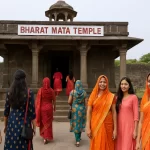
- Bhambavli Vajrai Waterfall, Satara, Maharashtra: India’s Natural Wonder

- Bhadra Maruti Temple Khuldabad, Chhatrapati Sambhaji Nagar (Aurangabad) – Divine History and Travel Guide
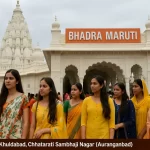
- Begusarai – Industrial Hub of Mithila Heritage

- Banoti Waterfall, Maharashtra: Where History and Nature Embrace

